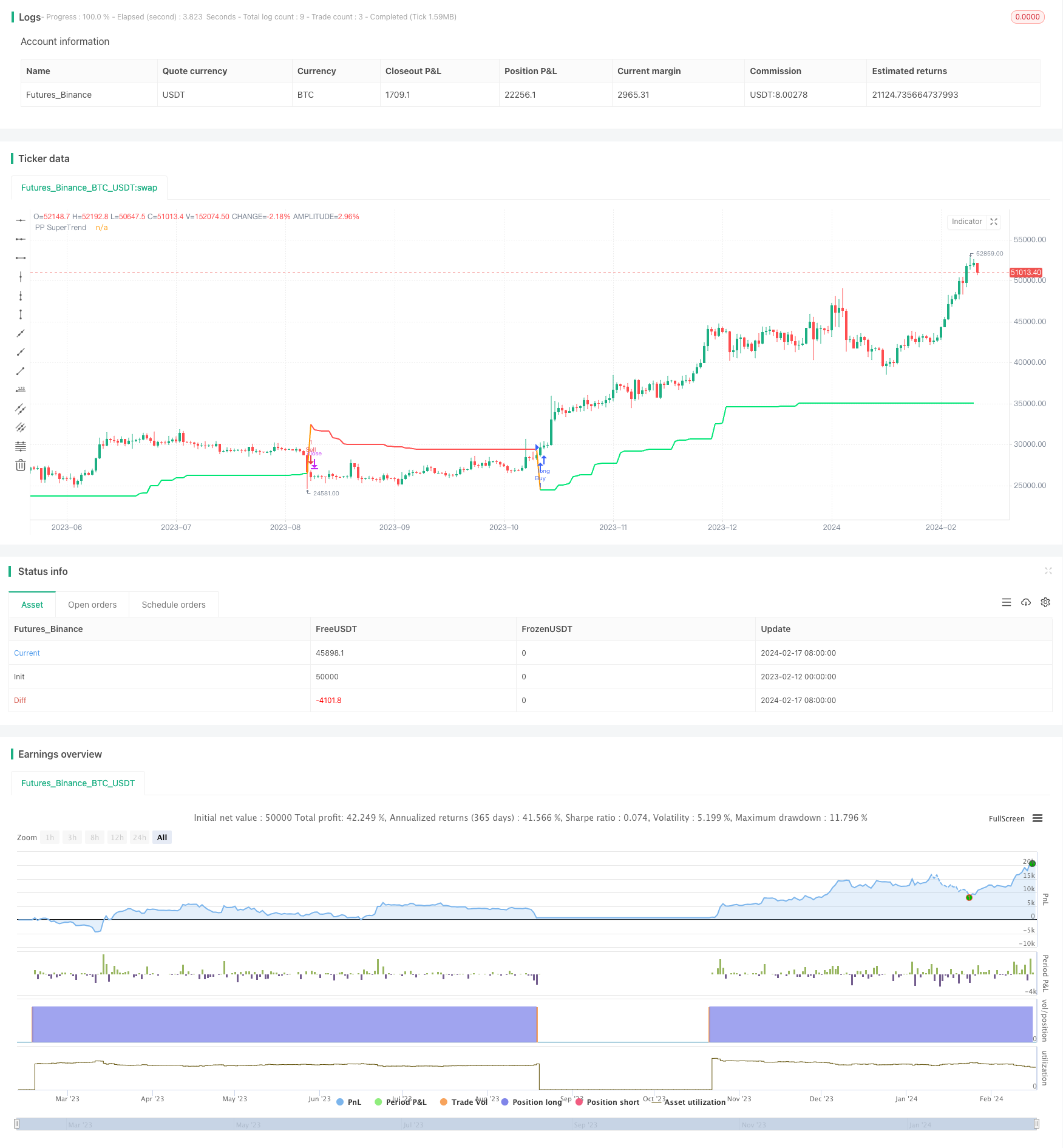
概述
本策略综合运用超趋势支撑阻力线和ADX指标来实现高频交易。超趋势支撑阻力线通过动态计算最新支撑阻力点,来判断价格趋势和发出交易信号。ADX指标用于判断趋势力度,设置ADX值为过滤条件,只在趋势足够强劲时发出交易信号。
策略原理
计算支撑阻力线。以收盘价为基准,上下各添加一个ATR幅度。当价格突破这些线时,判断为趋势反转。
ADX指标判断趋势力度。当ADX高于设置值时,认为趋势足够强劲。
结合两者发出交易信号。只在突破支撑阻力线且ADX足够大时,做多做空。
优势分析
该策略具有以下优势:
超趋势线动态计算支撑阻力,能快速判断突破。
ADX指标有效过滤非趋势场景,减少无效交易。
回撤和盈亏比良好。
风险分析
该策略也存在以下风险:
大幅跳空可能致使超趋势线失效。
ADX值设定不当也会影响策略表现。
高频交易交易费用较高。
对应解决方法:
优化超参数,适当放宽突破幅度。
测试更优ADX参数。
适当降低交易频率。
优化方向
该策略可从以下方面进行优化:
优化ATR倍数参数,使支撑阻力线更稳健。
测试不同ADX参数,找到最优值。
加入止损机制以控制单次损失。
总结
本策略整合超趋势线和ADX指标的优点,通过动态计算支撑阻力判断趋势反转时机,配合ADX指标过滤低质量信号。经过参数优化和机制调整后,可以成为一个稳定盈利的高频策略。
策略源码
/*backtest
start: 2023-02-12 00:00:00
end: 2024-02-18 00:00:00
period: 1d
basePeriod: 1h
exchanges: [{"eid":"Futures_Binance","currency":"BTC_USDT"}]
*/
//@version=4
strategy("STPP20 + ADX", overlay = true)
///////////////////////////
// SuperTrend + Pivot Point
//////////////////////////
src = input(close, title="EMA Source")
PPprd = input(defval = 2, title="Pivot Point Period", minval = 1, maxval = 50)
AtrFactor=input(defval = 5, title = "ATR Factor", minval = 1, step = 0.1)
AtrPd=input(defval = 20, title = "ATR Period", minval=1)
float ph = na
float pl = na
ph := pivothigh(PPprd, PPprd)
pl := pivotlow(PPprd, PPprd)
float center = na
center := center[1]
float lastpp = ph ? ph : pl ? pl : na
if lastpp
if na(center)
center := lastpp
else
center := (center * 2 + lastpp) / 3
Up = center - (AtrFactor * atr(AtrPd))
Dn = center + (AtrFactor * atr(AtrPd))
float TUp = na
float TDown = na
Trend = 0
TUp := close[1] > TUp[1] ? max(Up, TUp[1]) : Up
TDown := close[1] < TDown[1] ? min(Dn, TDown[1]) : Dn
Trend := close > TDown[1] ? 1: close < TUp[1]? -1: nz(Trend[1], 1)
Trailingsl = Trend == 1 ? TUp : TDown
// Lines
linecolor = Trend == 1 and nz(Trend[1]) == 1 ? color.lime : Trend == -1 and nz(Trend[1]) == -1 ? color.red : na
plot(Trailingsl, color = linecolor , linewidth = 2, title = "PP SuperTrend")
bsignalSSPP = close > Trailingsl
ssignalSSPP = close < Trailingsl
///////
// ADX
//////
lenADX = 14
th = 25
TrueRange = max(max(high-low, abs(high-nz(close[1]))), abs(low-nz(close[1])))
DirectionalMovementPlus = high-nz(high[1]) > nz(low[1])-low ? max(high-nz(high[1]), 0): 0
DirectionalMovementMinus = nz(low[1])-low > high-nz(high[1]) ? max(nz(low[1])-low, 0): 0
SmoothedTrueRange = 0.0
SmoothedTrueRange := nz(SmoothedTrueRange[1]) - (nz(SmoothedTrueRange[1])/lenADX) + TrueRange
SmoothedDirectionalMovementPlus = 0.0
SmoothedDirectionalMovementPlus := nz(SmoothedDirectionalMovementPlus[1]) - (nz(SmoothedDirectionalMovementPlus[1])/lenADX) + DirectionalMovementPlus
SmoothedDirectionalMovementMinus = 0.0
SmoothedDirectionalMovementMinus := nz(SmoothedDirectionalMovementMinus[1]) - (nz(SmoothedDirectionalMovementMinus[1])/lenADX) + DirectionalMovementMinus
DIPlus = SmoothedDirectionalMovementPlus / SmoothedTrueRange * 100
DIMinus = SmoothedDirectionalMovementMinus / SmoothedTrueRange * 100
DX = abs(DIPlus-DIMinus) / (DIPlus+DIMinus)*100
ADX = sma(DX, lenADX)
//////
// MA
/////
lenMA = 21
srcMA = input(close, title="Source")
offsetMA = input(title="Offset", type=input.integer, defval=0, minval=-500, maxval=500)
outMA = sma(srcMA, lenMA)
// Buy - Sell Entries
buy = bsignalSSPP and outMA < close and ADX > th
sell = ssignalSSPP
if (buy)
// .order // Tuned version
strategy.entry("Buy", strategy.long)
if (sell) and (strategy.position_size > 0)
strategy.order("Sell", false, when = sell)